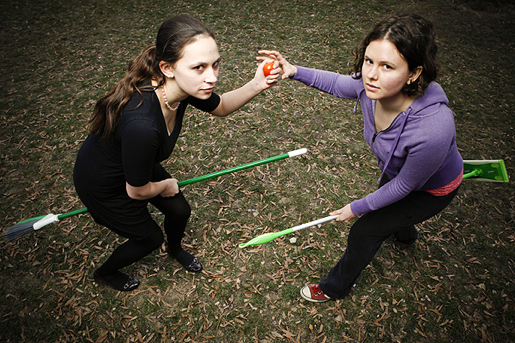At Mason, You Don't Have to Be a Wizard to Seek a Snitch

George Washington University sophomores Jenny Durina, left, and Kelsey McPherson practice their form of Quidditch in the school's University Yard. They started a league at GW, and now one is starting at Mason. (Chris Gregory / The GW Hatchet)
-------------------
UPDATED 1:33 a.m.
A magical new intramural club has joined the George Mason University ranks, and it’s not one many would expect. Quidditch, the wizardly sport created by J.K. Rowling in her Harry Potter novel series, has cast a spell on college campuses across the country, and Mason is now one of them.
While it may have never been played at a real Hogwarts, clubs at various other universities play the game, which has been adapted for practical, “Muggle” use. Now, co-captains and Mason students Katie Dever and Chloe Kingsley-Burt have formed an official Mason club to join an already established national league — the Intercollegiate Quidditch Association.
Started in 2005 by an intramural league at Middlebury College in Middlebury, Vermont, the Association, officially established in 2007, now encompasses over 226 universities.
Rules for the game were adapted from Rowling’s Harry Potter novels by Middlebury student and first Quidditch Commissioner Alexander Manshel. Kingley-Burt describes the adapted game as a combination of tag, flag-football, basketball and dodgeball, all rolled into one.
Once a university has officially joined the league, they are given an official rulebook that entails in explicit detail how the game has been adapted from the books to actual human practice.
To start, there are seven players on a Quidditch team: three chasers, two beaters, one keeper and a seeker.
“The game is actually very similar to the book,” said Mason Quidditch Co-captain Katie Dever. “Except for the snitch, [which is a flying gold ball that flits around on its own during game play]. [Also], beaters don’t have a club; they have a dodge ball instead. The concept for each position is basically the same.”
As imagined by Rowling in her books, beaters use a club to hit a ball, called a “bludger,” to knock players off their flying brooms. In the nonfiction version, beaters may throw dodge balls at players to knock them off their real-life, non-enchanted brooms.
Players must stay on actual brooms, from wicker to Swiffer, at all times during the game; if at any time they are struck with a dodge ball, they must simulate “falling off their broom” by running a lap around the field.
The Mason team has modified the physical contact rules to exclude unnecessary roughness.
Soccer balls or volleyballs represent “quaffles,” described as spherical balls used to score points in three goals of varying height at either end of the field.
But what about the game-ending and winning ball, the golden snitch?
“It’s somebody dressed all in gold with a tennis ball in a sock hanging off [his or her] back,” said Kingsley-Burt. “To catch the snitch, you have to get the tennis ball out of the sock instead of just touching them.”
Co-captain Katie Dever said that the idea for a Mason Quidditch team came about after her friend who attends Boston University said she was heading out for Quidditch team tryouts.
After garnering interest from Mason friends, co-captains Dever and friend Chloe Kingsley-Burt set out to organize the teams into individual “houses” — a traditional dormitory system in British boarding schools.
“There was definitely a response,” said Kingsley-Burt. “It was still kind of a cult thing, but we got a lot more people than we expected.”
Once houses were assigned, Kingsley-Burt and Dever placed players in their desired positions. Looking ahead, the co-captains hope to create a travel team for “hardcore” players.
“Before Harry Potter, I hated reading,” said Dever. “After that, I found it and my best friends are interested in it too. Its great to have people come together.”
The club was deemed an official Mason club a few weeks ago; before then, the Quidditch team could not reserve field space on campus.
“We’re ready now,” said Kingsley-Burt. “[We’ve] got a bunch of schools asking us to compete in a tournament; we were originally planning on a tournament at the end of the year, but now it looks like we’ll just do our own Mason House Cup tournament.”
Last year, 25 teams competed in the 2009 World Cup of Quidditch at Middlebury, including Virginia Commonwealth University.
While other universities, such as Middlebury and Princeton, stick to their universities’ traditional mascots, Dever and Kingsley-Burt assigned their friends to four Harry Potter houses: Gryffindor, Hufflepuff, Ravenclaw and Slytherin.
Teams are encouraged to wear their houses’ colors to matches, but intercollegiate Quidditch players don’t emulate characters from the Rowling novels as they play.
